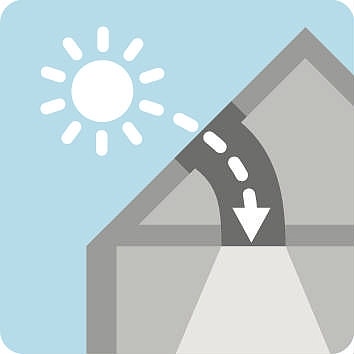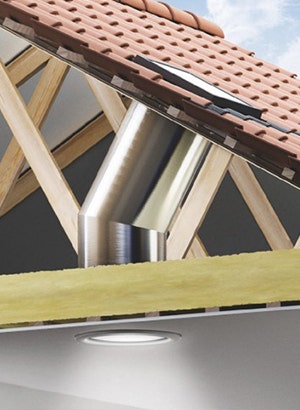Buying Guides
What is a Sun Tunnel, Solar Tube or Tubular Skylight?


Getting natural light into a room with no windows is a challenge many homeowners face. Loft conversions and attics often do not have access to natural light and installing a solar tunnel or solar tube is one way of lighting the room with natural light. So what is a solar tube and how does it work? This article will introduce you to solar pipes (sun tunnels), how they work, what things you need to consider before installing one, approximate costs and other aspects of solar tubes you need to know.
What is a Sun Tunnel/ Solar Tube?
A sun tunnel is a rigid or fixed pipe installed through the roof to convey light from the outside to a room within the house. The interior of the sun tunnel is a highly reflective surface, designed to allow light to travel from the outside into the room. A transparent cover is installed on the roof (roof dome) and a diffuser (helps spread the light around the room) at the terminal end in the ceiling. Sun tunnels are often called sun pipes, solar tubes, sky tubes, solar tunnels or solar tubes.
Natural light is guided down the shiny interior of the solar pipe into the room. This method of lighting spaces is environmentally friendly because it does not require electrical energy input and is 100% natural.
 How a Sun Tunnel works
How a Sun Tunnel works
Due to the natural properties of light, the shorter the tunnel length, the better the quality of light you will enjoy in the room.
Installing a solar tube or sun tunnel
Sun tunnels are very much like roof or Velux windows in their installation. You can install a solar tube (solar tunnel) in almost any type of roof structure, and the considerations you need to make are the same. If you have the experience of installing a roof window, then you will find the same skills will come in handy when installing a sun tunnel. If you are a keen DIYer, you can consider installing the solar tube yourself. However, choosing the right solar tube and selecting the perfect installation location may require a little more experience with solar tubes.
Choosing the right solar tunnel type
Which is the better option; a flexible solar pipe or the rigid solar tunnel type? This is not a simple question to answer because the choice of tunnel type will depend on the following factors:
- Available space on roof and in the room.
- Accessibility through loft space.
- Distance between ceiling and roof.
- Budget.
- Ease of installation.
The rigid solar tunnel is perfect for long runs where there are no obstructions in place from the roof to the ceiling. With the correct roof orientation, a rigid solar tube will give you maximum light output. If you are designing a new build to incorporate solar tubes, then using rigid solar tunnels will give you the best light output.
 Rigid Sun Tunnel Rigid Sun Tunnel |
 Flexible Sun Tunnel Flexible Sun Tunnel |
Flexible Solar Tunnels or Tubular Skylights, on the other hand, are ideal for retrofit projects, loft conversions and situations where there are space restrictions in the roof space. When you have to go around beams and other obstructions, the flexible sun tunnels will work best. It is always essential to ensure the angle of any bends in not extreme to minimise loss of light once installed. This type of solar tunnel is most suitable for short runs.
How much light can a sun tunnel provide?
The next question to answer when it comes to sun tunnels is how much light you can expect to get by installing one. There are a number of factors which affect the overall amount of light available in the room. These include:
- The size of the solar tunnel.
- The orientation of the roof where the sun tunnel is installed.
- The type of sun tunnel used.
If you consider the information from many sun tunnel manufacturers, they will quote the lumen output of their products. These figures mean nothing to the average homeowner so instead, we will use standard power outputs as a reference.
The simplest way to explain the output you can expect from the different types and sizes of solar tunnels is to compare it to the output of a typical light bulb. The most common sizes are 10” and 14” with optimum lengths of 1 metre and installed in a south-facing orientation. Typical light outputs to expect are as follows:
- 10” size expect between 150-200 watts.
- 14” size expect up to 250 watts output.
Flexible solar tunnel light output
As the length of the solar tunnel increases, you can expect marked reductions in output. If the installation is in a non-south-facing orientation and using flexible sun tunnel 2m in length, then expect outputs of around 60 watts and 80 watts for 10” and 14” size sun tunnels, respectively.
Practical installation considerations for sun tunnels
So far we have explained how the type, size, length and roof orientation of a solar tunnel will affect the light you will enjoy in your rooms. Choosing the shortest possible run of rigid sun pipe and then installing it in a south-facing position is the optimum scenario. However, not all installations are that straightforward. Now we will consider the practical aspects of installing sun pipes, including cutting out space in the roof and ceilings.
Tips for cutting timbers to accommodate sun tunnels
Always ensure you carry out a survey of the roof and roof space so that you’re familiar with the positioning of the roof joists, trusses and rafters. The simplest solution is to work around the existing timber roof structure and making minimal alterations. Ensure you consult a professional builder or structural engineer before cutting into structural timbers.
Before installing also check for the following:
- Plumbing and electrical services which may require moving or avoiding.
- Purchase a sun tunnel kit which comes with all instructions and cutting templates. Ensure you read the instruction in detail and cut the internal openings first before disturbing the roof work.
Working on your roof may require the help of an experienced roofer so that you do not compromise the integrity of your roof. Roof penetrations are the most common source of roof leaks. If the openings you make for the solar tunnel are not sealed adequately, you may have a leaking roof in the future. Ensure you take the appropriate steps to weatherproof the sun tunnel by installing flashing around the dome.
Post installation and maintenance
Solar tunnels need minimal maintenance once in place. Keeping the dome clean is often adequate. If installed correctly, the only thing you will need to check is the flashing during an annual roof inspection. There is very little that could go wrong with a solar tunnel, making them virtually maintenance-free.







